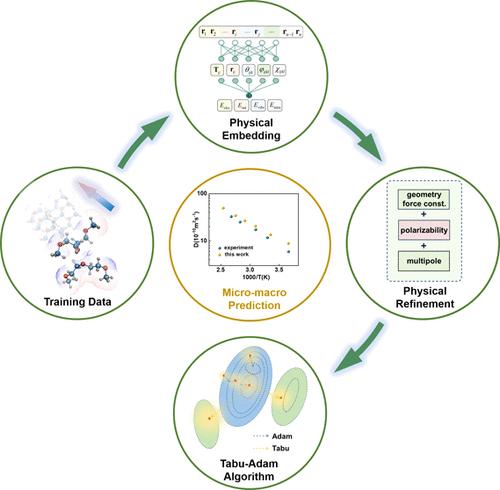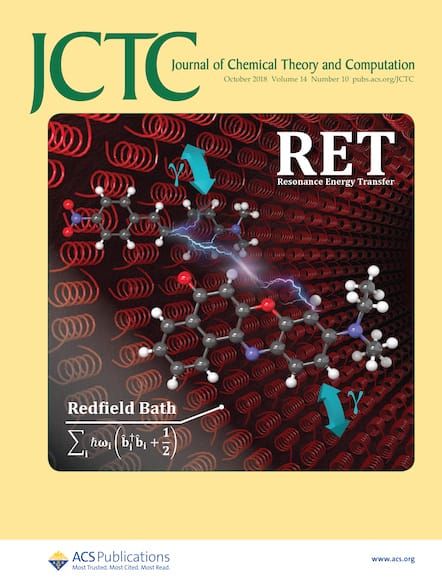Synergistic Integration of Physical Embedding and Machine Learning Enabling Precise and Reliable Force Field
IF 5.7
1区 化学
Q2 CHEMISTRY, PHYSICAL
引用次数: 0
Abstract
Machine-learning force fields have achieved significant strides in accurately reproducing the potential energy surface with quantum chemical accuracy. However, this approach still faces several challenges, e.g., extrapolating to uncharted chemical spaces, interpreting long-range electrostatics, and mapping complex macroscopic properties. To address these issues, we advocate for a synergistic integration of physical principles and machine learning techniques within the framework of a physically informed neural network (PINN). This approach involves incorporating physical knowledge into the parameters of the neural network, coupled with an efficient global optimizer, the Tabu-Adam algorithm, proposed in this work to augment optimization under strict physical constraint. We choose the AMOEBA+ force field as the physics-based model for embedding and then train and test it using the diethylene glycol dimethyl ether (DEGDME) data set as a case study. The results reveal a breakthrough in constructing a precise and noise-robust machine learning force field. Utilizing two training sets with hundreds of samples, our model exhibits remarkable generalization and density functional theory (DFT) accuracy in describing molecular interactions and enables a precise prediction of the macroscopic properties such as the diffusion coefficient with minimal cost. This work provides valuable insight into establishing a fundamental framework of the PINN force field.

物理嵌入与机器学习的协同集成实现了精确可靠的力场
机器学习力场在以量子化学精度准确再现势能面方面取得了长足进步。然而,这种方法仍然面临着一些挑战,例如,推断未知的化学空间、解释长程静电以及映射复杂的宏观特性。为了解决这些问题,我们主张在物理信息神经网络(PINN)框架内,将物理原理和机器学习技术进行协同整合。这种方法包括将物理知识纳入神经网络参数,并与本研究中提出的高效全局优化器--塔布-亚当算法(Tabu-Adam algorithm)相结合,以增强严格物理约束下的优化。我们选择 AMOEBA+ 力场作为基于物理的嵌入模型,然后以二乙二醇二甲醚(DEGDME)数据集为案例对其进行训练和测试。研究结果表明,在构建精确且噪声低的机器学习力场方面取得了突破性进展。利用两个包含数百个样本的训练集,我们的模型在描述分子相互作用时表现出卓越的泛化能力和密度泛函理论(DFT)准确性,并能以最低成本精确预测扩散系数等宏观性质。这项工作为建立 PINN 力场的基本框架提供了宝贵的见解。
本文章由计算机程序翻译,如有差异,请以英文原文为准。
求助全文
约1分钟内获得全文
求助全文
来源期刊

Journal of Chemical Theory and Computation
化学-物理:原子、分子和化学物理
CiteScore
9.90
自引率
16.40%
发文量
568
审稿时长
1 months
期刊介绍:
The Journal of Chemical Theory and Computation invites new and original contributions with the understanding that, if accepted, they will not be published elsewhere. Papers reporting new theories, methodology, and/or important applications in quantum electronic structure, molecular dynamics, and statistical mechanics are appropriate for submission to this Journal. Specific topics include advances in or applications of ab initio quantum mechanics, density functional theory, design and properties of new materials, surface science, Monte Carlo simulations, solvation models, QM/MM calculations, biomolecular structure prediction, and molecular dynamics in the broadest sense including gas-phase dynamics, ab initio dynamics, biomolecular dynamics, and protein folding. The Journal does not consider papers that are straightforward applications of known methods including DFT and molecular dynamics. The Journal favors submissions that include advances in theory or methodology with applications to compelling problems.
 求助内容:
求助内容: 应助结果提醒方式:
应助结果提醒方式:


